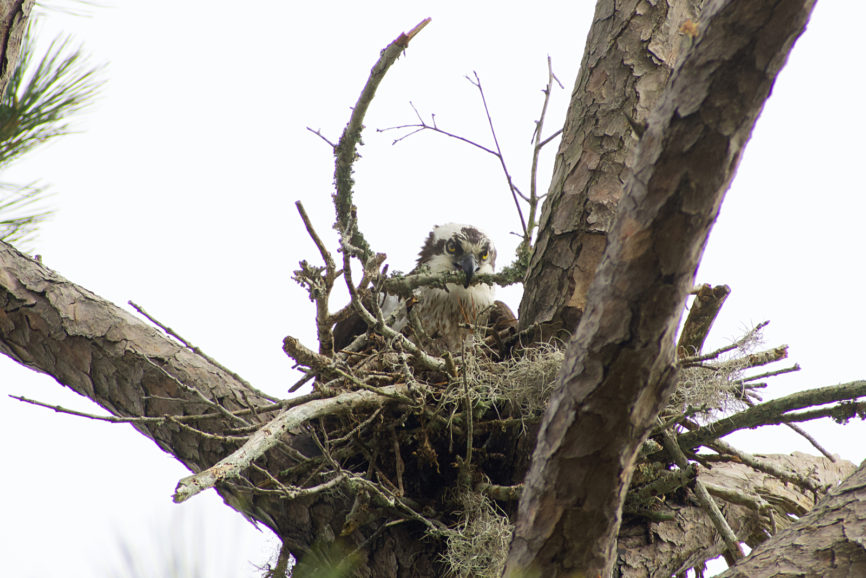The return of ospreys to the Outer Banks does not have quite the memorable turn of phrase as the “Swallows of Capistrano.” However, every spring, when this magnificent bird of prey returns to coastal North Carolina, it is a thing of wonder.
Ospreys are one of the most distinctive birds of the Outer Banks. Their long thin wings are about 5’ across, the head is white and brown, and should you get close enough to notice, there is a well-defined sharp hook to their beak.
They look a bit like eagles, but they are classified as either their own species or a subspecies of hawks—there is some discussion on various websites about which they are. In-flight, the difference between ospreys and eagles or hawks is readily apparent, though. The broader, stockier wings of eagles and hawks are quite different in-flight from the long gliding wings of an osprey.
There are a lot of remarkable characteristics to Pandion haliaetus, to give it its Latin name.

It is a migratory bird, traveling between 2000-3000 miles between its breeding areas in North America and its winter home in Central and South America. They are also primarily monogamous birds, usually mating for life. One of the most extraordinary characteristics of osprey is that once the mating couple has established a nest, they almost always return to it year after year. Since ospreys often live to be 20 years of age, their nests become very well established.
The nest can get quite large. Because the mating pair keep coming back to the same site every year, they have to maintain and repair the nest each time they return. Consequently, the nest may become so big that small birds will build their own nests along the outer ring. A study of osprey nests in the Great Lakes found common grackles, tree swallows, European starlings, and house sparrows nesting alongside osprey.
To the best of our knowledge, no one has studied this phenomenon in Outer Banks osprey, so we can’t say definitively that it’s happening—but the behavior is so common there is no reason to think it is not.
Osprey’s diet consists almost entirely of fresh fish, and they are remarkably adept at catching their dinner. Typically a fish is grabbed in one out of every four dives, and according to a number of studies, an osprey only spends about 12 minutes hunting before spotting its prey.
There are some very distinctive things about how they hunt and how they handle the fish they catch.
Before making their dive, they tend to hover briefly, and when they make that dive, they go in feet first with their legs extended past their head. It seems to be the only raptor that takes its prey in that manner, and by doing so, their eyes can remain focused throughout the dive. When osprey hit the water, they will at times completely submerge themselves. In-flight, they appear to shake the excess water off a lot like a dog would do.
The talons are one of the most remarkable characteristics of the osprey. They actually have four talons on each leg; two on the front and two on the back, almost forming a circle. Inside their talons, there are heavy scales and small, needle-like spikes—spicules—that enable them to grasp the fish.
And there’s another amazing characteristic of their talons. The outer talon can rotate forward and backward, sort of like an opposable thumb. What that allows the osprey to do is align the fish’s head in the direction of flight to reduce drag. Because they are very strong fliers and coupled with the ability to minimize wind resistance as they fly, an osprey can lift up to 25% of its body weight.
That actually is not that much weight. For all their physical size, ospreys do not weigh very much at all—three-and-a-half to four pounds is a typical adult weight. The females tend to be larger than the males.
The female usually lays between 2-4 eggs, although four eggs are somewhat uncommon. Incubation is about a month to a month and a half, with the female incubating the eggs for the most part, although the male will take a turn when the female is eating. The eggs do not all hatch at the same time. When there is plenty of food, that is not a problem, but during a period where food may be hard to find, the last chick to hatch may not survive.
Because the hunting technique of ospreys is fairly sophisticated, the chicks have to learn what to do. As summer winds down and into early fall, a thrilling sight and sound is the high-pitched screech of osprey as the male and female fly, with the fledgling osprey following their moves.
Ospreys are one of the most common birds of prey on the Outer Banks. Easily identified and not nearly as secretive or nesting in remote areas as bald eagles or hawks, seeing one of these magnificent birds is a wonderful part of the Outer Banks experience.





